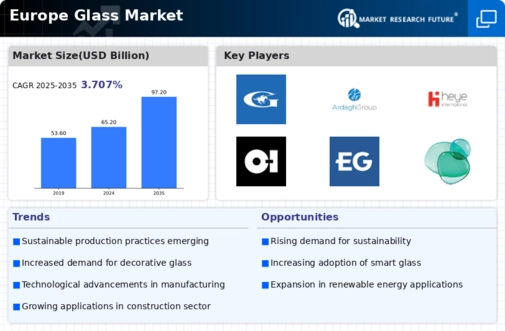Consumer Demand for Customization
In recent years, there has been a noticeable shift in consumer preferences towards personalized products, significantly impacting the glass market. European consumers are increasingly seeking customized glass solutions for both functional and aesthetic purposes. This trend is evident in sectors such as home decor, where bespoke glass designs are gaining popularity. According to market data, the demand for customized glass products has surged by approximately 15% annually, indicating a robust growth potential. Manufacturers are responding by investing in advanced production techniques that allow for greater flexibility and creativity in design. This consumer-driven demand for customization is likely to propel innovation and diversification within the glass market, fostering a more dynamic competitive environment.
Regulatory Framework Enhancements
The evolving regulatory landscape in Europe plays a crucial role in shaping the glass market. Stricter environmental regulations and standards are being implemented, compelling manufacturers to adopt sustainable practices. For instance, the European Union's directives on waste management and recycling are pushing glass producers to enhance their recycling capabilities. This shift not only aligns with sustainability goals but also opens new avenues for innovation within the glass market. As a result, companies that proactively adapt to these regulations may gain a competitive edge, potentially increasing their market share. The emphasis on compliance is likely to drive investments in cleaner technologies, thereby influencing the overall growth trajectory of the glass market.
Architectural Trends Favoring Glass
Contemporary architectural trends in Europe are increasingly favoring the use of glass in building designs, which is having a profound impact on the glass market. The preference for open, light-filled spaces has led to a surge in demand for large glass facades and windows. This architectural shift is reflected in recent data, indicating that the use of glass in construction has increased by 20% over the past three years. Architects and builders are recognizing the aesthetic and functional benefits of glass, such as energy efficiency and natural lighting. Consequently, this trend is likely to drive innovation in glass manufacturing techniques, as companies strive to meet the evolving demands of the construction industry. The architectural focus on glass is expected to sustain growth in the glass market for the foreseeable future.
Growth in Renewable Energy Applications
The transition towards renewable energy sources is significantly influencing the glass market in Europe. Glass is increasingly being utilized in solar energy applications, such as photovoltaic panels and solar thermal systems. The European market for solar glass is projected to grow at a CAGR of 12% over the next five years, driven by the rising adoption of solar technologies. This growth is further supported by government incentives aimed at promoting renewable energy solutions. As the demand for energy-efficient and sustainable building materials rises, the glass market is likely to benefit from increased investments in solar glass production. This trend not only enhances the market's sustainability profile but also positions it favorably within the broader context of the green energy transition.
Technological Advancements in Production
Technological advancements in glass production processes are reshaping the landscape of the glass market in Europe. Innovations such as automated manufacturing and advanced quality control systems are enhancing efficiency and reducing production costs. Recent studies suggest that the implementation of these technologies can lead to a reduction in production time by up to 30%, thereby increasing output capacity. Furthermore, the integration of smart technologies in glass manufacturing is enabling the production of high-performance glass products that meet stringent energy efficiency standards. As manufacturers continue to invest in these advancements, the glass market is likely to experience enhanced competitiveness and growth. This technological evolution not only improves product quality but also aligns with the increasing demand for sustainable and energy-efficient glass solutions.






















Leave a Comment